Pajero, sticking to what is tried and proven
Pajero has successfully created a mark in Jamaica that is emboldened by hard work and success without the flair and flashiness. Before the compact SUV dominated the market, or mid-size SUVs like BMW X5 or Audi Q7 existed, the Pajeros were the vehicles to drive. They were polished enough to go to a business function but rugged enough to tackle any off-road conditions. Fortunately for many, the brand has stuck to this formula with the current model.
It also has a long, impressive history of off-road driving as it has spent some time in the Dakar Rally's record book, which highlights its ability to manage rugged situations.
For our market, the second-generation model that came out in 1991 was an instant hit with automotive lovers. By 1997, Pajero became a status symbol for high-ranking businessmen, and when a redesign came in 1999, it became every politician's go-to vehicle. Now in its fourth generation, Mitsubishi decided to make some minor adjustments.
For the exterior, the entire sheet metal seems more streamlined to give the vehicle a slightly thinner look. Gone are the protruding wheel arches and the arched bonnet from the previous generation. Now, it boasts LED daytime running lights that are housed beside the fog lights. Other distinctive features are the chrome side mirrors with indicator lights at the base.
What's on the inside
Inside the Pajero feels large with well-stitched black leather seats, complemented with chrome and wood grain throughout. It's obvious that Pajero will not abandon its core market and as such, there isn't a learning curve for someone who is stepping up from the previous model.
The seven-inch touchscreen functions quite simply if you are looking for a radio station or tuning the speakers. It is paired with a Rockford Fosgate sound system, which consists of 12 speakers, including tweeters, woofers, and subwoofers. Positioned throughout Pajero, they are optimally balanced for music lovers, with a default acoustic sound.
In the rear, the second-row seats split 60/40 and can be reclined to a respectable angle. There are also A/C vents mounted in the roof, and the temperature can be controlled by two knobs at the rear of the centre console.
As for the third-row seats, they are going to take some effort to pull from the floor as they require removing the floor mat then doing a two-step execution. Fortunately for these passengers, they will also have their climate-control knobs and cup holders.
The customary sunroof is still there as well as the leather-trimmed steering wheel, but this time, there are more buttons dedicated to the radio, phone functions, and cruise control.
Still fit to manage off road challenges
The 3-litre 24-valve V6 engine is all about torque, which is evident by its growling sound, which makes the driver know that it will not have any trouble hauling around persons.
For the most part, the underpinnings of this vehicle seem to have remained the same with a little tweaking here and there. To start, the all-wheel independent suspension, gives drivers confidence and predictable handling in even the most challenging road conditions. The front double-wishbone and rear multilink suspensions use coil springs that comfortably get the job done. The suspension set-up also helps each wheel to raise, lower, and pivot independently, keeping more tyre surface against the ground for greater stability.
The vehicle still has its tried and proven off-road features that incorporated 4-wheel traction, power- and slip control. There are four driving modes to select from - depending on the terrain - which are 2-wheel high range (2H), 4-wheel high range (4H), and 4-wheel high and low with locked central differentials (4HLc or 4LLc).
One of the cool things is that the lever can be shifted among 2H, 4H, and 4HLc at speeds up to 100 km/h. However, the vehicle must be stopped when switching between 4HLc and 4LLc.
For regular commute, it is recommended to keep the vehicle in 2h as power is sent to the rear wheels only, and it is most fuel efficient in this mode. In 4H, the dynamic front/rear torque split adjusts between 33:67 and 50:50 to give greater control for high-speed driving. For 4HLc mode, power is distributed to all four wheels equally for off-road excitement, with a steady sense of control. Finally, there is 4LLc for tractor-like crawling power, and the low-end torque is maximised to give you all the power.
The vehicle feels mechanically stable, but it also feels heavier than the 4,640.7lbs it is listed at. It is evident that the Pajero's internal parts are due for an upgrade soon to keep up with the lighter materials that its counterparts are using. Again, this is a matter of preference, as many of the 'traditional' guys prefer heavier vehicles.
The Pajero is an old-school SUV as it stays true to its fundamental principles of reliability and durability. Admittedly, this won't be for everyone, but at least the brand is not in the business of deceiving its buyers, what you see is what you get.
Standard features
- 18"alloys with 265/65R18 tyres
- USB connectivity for SMART devices
- 4-speed automatic with sports mode and shift-tronic manual select.
- Factory-installed alarm with interior motion detectors.
- Eight airbags (front, side, and curtain)
- Reverse camera
- Model tested: Mitsubishi Pajero GLS at $8.15* million.
- Low specs: 3-litre V6 engine, fabrics seats, standard features $7.65*.
- High specs: Leather seats, sunroof, Rockford Fosgate speakers, wooden trim interior, 3-litre gas engine at $8.15* million and 3.2-litre diesel engine at $8.6* million.
- Competition: Toyota Prado.
- Contact information: contact@mitsubishijamaica.com, 876-928-5041-7
- Discounted for this month.
- For comments and feedbacks email, yl.jamaica@gmail.com





